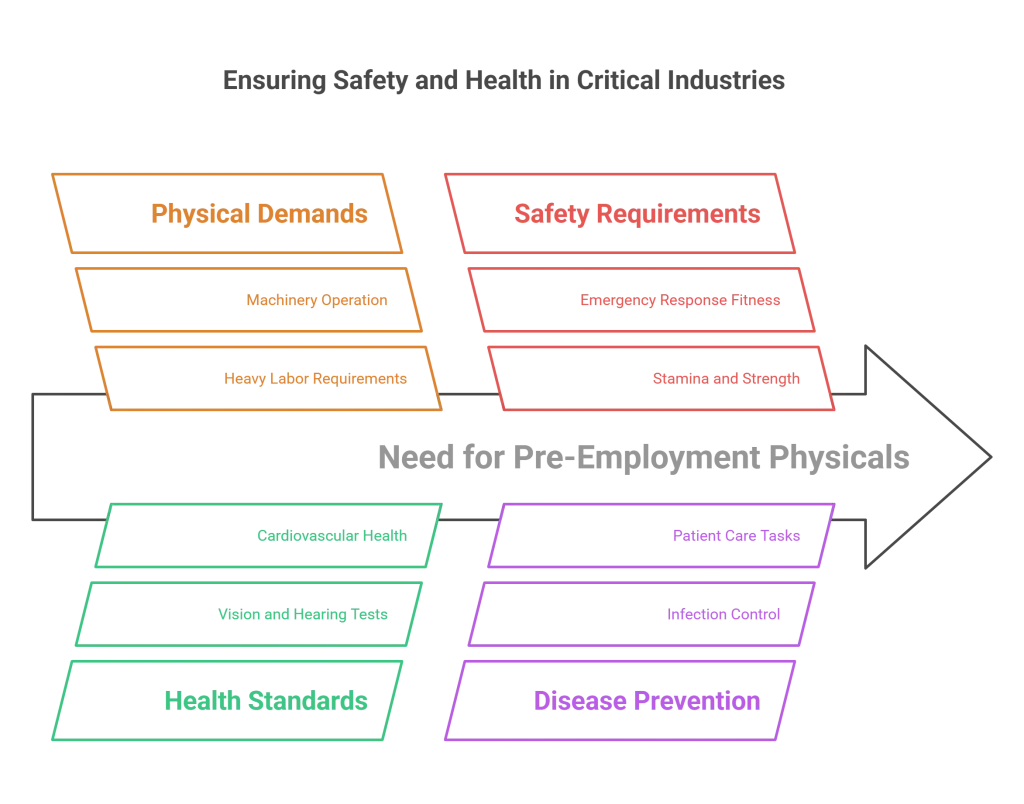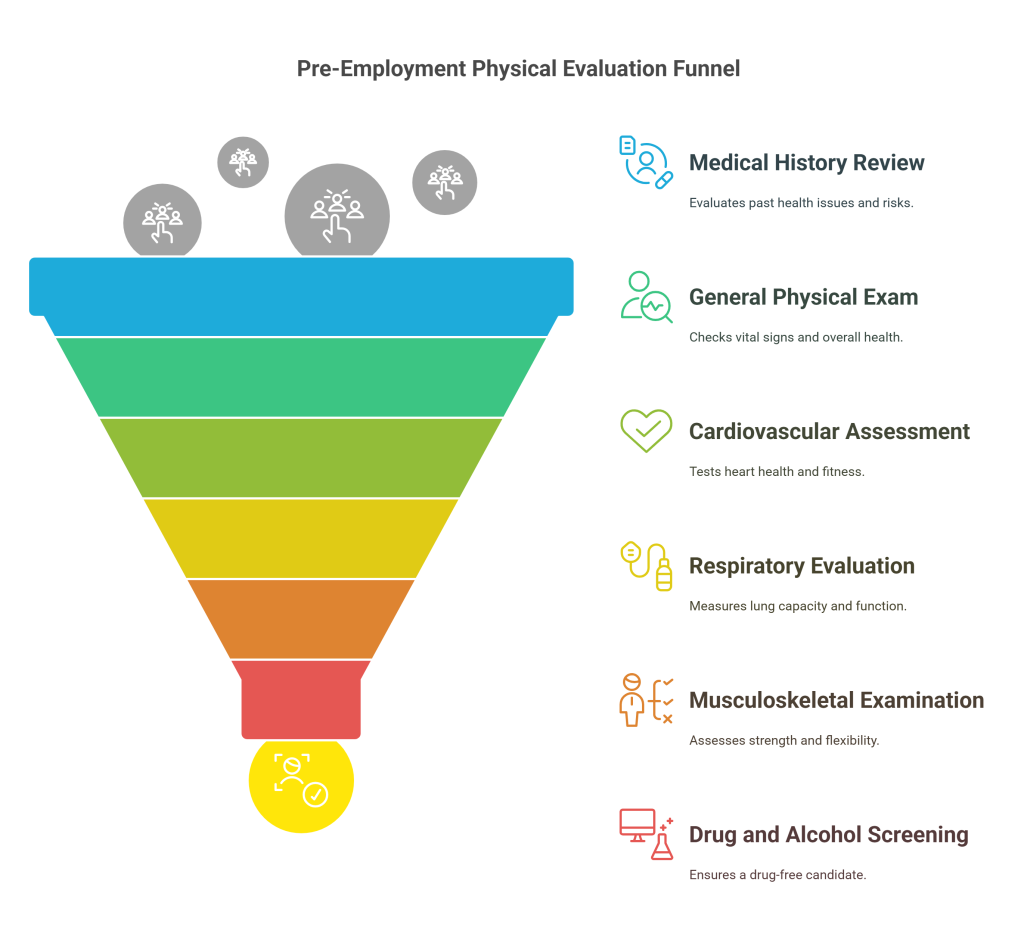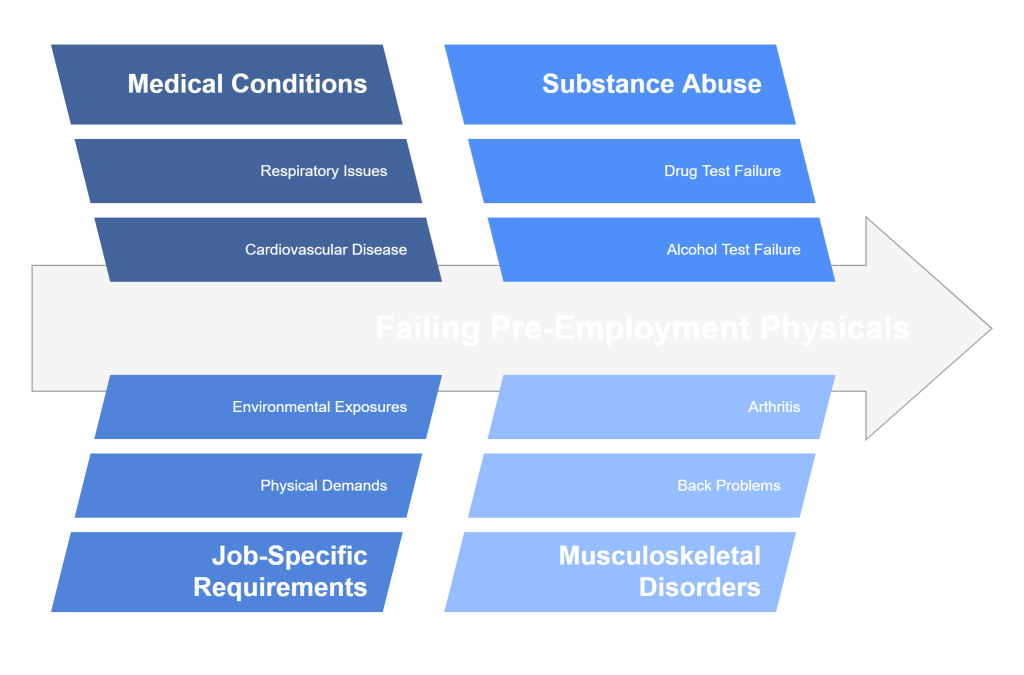Pre-employment physicals are a vital step in the hiring process for many companies. These exams help ensure potential employees are physically and mentally capable of performing their duties. They also identify any health issues that could pose risks in the workplace. This guide will explore the importance of pre-employment physicals, its benefits, and how employers and job seekers can prepare for them. By understanding these exams, employers can create a safer work environment, and job seekers can confidently approach the process. Let's delve into the critical aspects of pre-employment physicals.
Key Takeaways
- Purpose: Ensure candidates can meet the physical and mental demands of the job, reducing workplace injuries and health-related absences.
- Common Components: Include medical history review, physical examination, cardiovascular and respiratory assessments, drug and alcohol screening, and vision and hearing tests.
- Industries Requiring Exams: Common in sectors like construction, transportation, healthcare, and public safety, where physical fitness is crucial.
- Legal Compliance: Employers must adhere to regulations like the Americans with Disabilities Act (ADA) and the Equal Employment Opportunity Commission (EEOC) guidelines when implementing these exams.
- Preparation Tips: Candidates should rest well, stay hydrated, and provide accurate medical histories to ensure a smooth examination process.
What is a Pre-Employment Physical?
A pre-employment physical is a medical examination that assesses whether a job applicant is fit to perform the duties required by the job. These exams aim to identify potential health issues that might interfere with job performance or pose a safety risk to the individual or others. Employers use pre-employment physicals to ensure a healthy and capable workforce, reducing the likelihood of workplace accidents and health-related absences. The exams can vary depending on the job's physical demands and industry standards. Common components include medical history reviews, physical exams, and health assessments. Understanding what a pre-employment physical entails can help job seekers prepare, and employers implement effective health and safety practices.
EXPERT INSIGHT: Pre-employment physicals are not only implemented to protect employees’ health but also ensure they can perform their jobs to the best of their abilities. As HR professionals, we look at them as a crucial part of creating a safe and thriving workplace. Through the keen identification of potential health risks at an early stage, we foster an environment where both employers and employees can succeed. At the heart of it, pre-employment physicals reflect our commitment to the people who will shape the future of our organizations and serve as the company's assets. - Charm Paz, CHRP
Common Components of a Pre-Employment Physical
- Medical History Review: The healthcare provider reviews the applicant's past medical conditions, surgeries, and treatments. This helps identify any chronic issues that might affect job performance.
- General Physical Exam includes checking vital signs like blood pressure, heart rate, and temperature to ensure overall health.
- Cardiovascular Assessment: Tests such as EKGs measure heart health and detect any cardiovascular issues that could be problematic in a physically demanding job.
- Respiratory Evaluation: Lung function tests check for respiratory health issues, ensuring the applicant can handle tasks that require good breathing capacity.
- Musculoskeletal Examination: This assesses physical strength, flexibility, and overall musculoskeletal health to determine if the applicant can perform physically demanding tasks.
- Drug and Alcohol Screening: Tests for the presence of illegal substances or alcohol ensure a safe and drug-free workplace.
- Vision and Hearing Tests: These tests confirm that the applicant meets the necessary sensory requirements for the job, which is crucial for roles requiring precise visual and auditory abilities.
Who Requires a Pre-Employment Physical?
Pre-employment physicals are often mandatory in industries where job performance can significantly impact safety and productivity. These exams are widespread in the construction, transportation, and healthcare sectors. Workers in these fields must meet specific physical standards to perform their duties safely and effectively. For example, a firefighter must have excellent cardiovascular health, while a truck driver needs good vision and hearing. Healthcare workers must be free from contagious diseases and in good overall health to care for patients. These industries can maintain high safety and health standards by requiring pre-employment physicals.

Industries and Job Roles Requiring Pre-Employment Physicals
- Construction: Workers must be physically capable of safely performing heavy labor and operating machinery. Tasks often involve lifting, climbing, and working in various environmental conditions.
- Transportation: Drivers must meet strict health standards to ensure public safety. They spend long hours on the road and must react quickly to avoid accidents.
- Healthcare: Medical professionals must be in good health to provide effective patient care and prevent the spread of illness. They need to handle physical tasks like moving patients and working long shifts.
- Public Safety: Firefighters, police officers, and other first responders must be physically and mentally fit to handle emergency situations. They need to perform strenuous activities under high stress.
Real-World Examples
- Firefighter: Requires high physical fitness and stamina to handle demanding emergency situations. They need to carry heavy equipment, climb ladders, and rescue individuals.
- Truck Driver: Needs good vision, hearing, and cardiovascular health to ensure safety on the road. They must drive for extended periods and handle the physical demands of loading and unloading cargo.
- Nurse: Must be physically capable of handling patient care tasks such as lifting, moving, and assisting patients. They also need to maintain good health to avoid transmitting infections.
Benefits of Pre-Employment Physicals for Employers and Employees

Benefits for Employers
- Ensuring a Safe and Productive Workforce: Pre-employment physicals help employers confirm that new hires can safely perform their job duties, reducing the risk of workplace accidents.
- Reducing Workplace Injuries and Accidents: By identifying potential health issues before hiring, employers can prevent injuries that could occur due to physical limitations or medical conditions.
- Lowering Workers' Compensation Costs: Healthy employees are less likely to file workers' compensation claims, saving employers money on insurance premiums and legal fees.
- Minimizing Absenteeism and Turnover: Employees in good health tend to have better attendance records and are less likely to leave the job due to health-related issues. This stability benefits overall productivity and morale.
Benefits for Employees
- Identifying Potential Health Issues: Early detection of health problems during a pre-employment physical can lead to timely treatment and better health outcomes.
- Ensuring Physical Fitness for the Job: These exams confirm that the employee is physically capable of handling job requirements, reducing the risk of injury.
- Promoting Overall Health and Well-Being: Knowing they are healthy can boost employee confidence and well-being, encouraging a proactive approach to personal health.
Components of a Pre-Employment Physical
According to OSF HealthCare, pre-employment physicals typically include a medical history review, physical examination, laboratory tests, vision and hearing tests, and physical fitness assessments. These exams help ensure that new employees are healthy and capable of performing their duties safely, thereby reducing the risk of workplace accidents and injuries. The guide also highlights the importance of identifying health issues early and protecting against liability.

Medical History Review
The medical history review is an essential part of the pre-employment physical. It helps the healthcare provider understand the applicant's past health issues and any current conditions that might affect job performance. This review includes questions about previous surgeries, chronic illnesses, and ongoing treatments. The information gathered can identify potential risks and determine if the applicant needs additional tests or evaluations. Understanding the medical history allows for a comprehensive assessment of the applicant's health.
General Physical Exam
The general physical exam includes checking vital signs such as blood pressure, heart rate, and temperature. These indicators provide a snapshot of the applicant's overall health. For instance, high blood pressure could signal underlying health issues that need addressing. The exam also includes basic assessments like weight and height measurements. This information helps the healthcare provider evaluate the applicant's fitness level and detect immediate health concerns.
Cardiovascular Assessment
Cardiovascular health is crucial, especially for physically demanding jobs. Tests such as EKGs measure the heart's electrical activity to detect abnormalities. Stress tests evaluate how the heart performs under physical exertion, essential for jobs requiring high levels of physical activity. These assessments help ensure the applicant can handle the job's physical demands without risking their health. Identifying cardiovascular issues early can prevent serious health problems in the workplace.
Respiratory Evaluation
Lung function tests ensure applicants can breathe well enough to perform job duties. These tests measure the capacity and efficiency of the lungs. Good respiratory health is crucial for jobs in environments with airborne hazards or requiring physical exertion. The evaluation can include spirometry tests, which measure the air an applicant can exhale and the speed of exhalation. Identifying respiratory issues can help prevent workplace incidents related to breathing problems.
Musculoskeletal Examination
This exam assesses physical strength, flexibility, and overall musculoskeletal health. It includes strength tests to measure the ability to lift and carry objects, flexibility tests to ensure the applicant can move freely without pain and posture assessments. Musculoskeletal health is important for jobs requiring physical labor or prolonged periods of standing or sitting. Identifying issues in this area can prevent workplace injuries and ensure the applicant can perform job duties safely and effectively.
Drug and Alcohol Screening
Many employers require drug and alcohol testing to ensure a safe and drug-free workplace. These screenings can include urine tests to detect the presence of illegal substances and blood tests to measure alcohol levels. Depending on company policies, a positive result can disqualify an applicant. Drug and alcohol screenings help maintain a safe work environment and reduce the risk of accidents caused by impaired employees.
Vision and Hearing Tests
Good vision and hearing are essential for many jobs. Vision tests check for visual acuity, color blindness, and peripheral vision. Hearing tests ensure the applicant can hear well enough to perform job duties safely, especially in environments with loud machinery or where communication is crucial. These tests confirm that the applicant meets the necessary sensory requirements for the job, which is vital for roles that require precise visual and auditory abilities.
Preparing for a Pre-Employment Physical
Job seekers can take several steps to prepare for a pre-employment physical. Being well-prepared can help ensure a smooth process and favorable results.
Tips for Job Seekers
- Get a Good Night's Sleep: Being well-rested can improve overall health markers, such as blood pressure and heart rate, during the exam.
- Eat a Healthy Breakfast: A nutritious meal can help maintain energy levels and focus, contributing to better performance during the physical tests.
- Wear Comfortable Clothing: Loose-fitting clothes make it easier to perform physical tests and provide access for the healthcare provider to conduct the examination.
- Bring Necessary Documentation: Include medical records, a list of medications, and any other relevant information. Having this documentation on hand can streamline the process and ensure accurate assessments.
Compliance and Legal Considerations
Employers must comply with federal laws when conducting pre-employment physicals. These laws protect the rights of job applicants and ensure fair treatment.
Relevant Federal Laws
- Americans with Disabilities Act (ADA): The ADA prohibits discrimination against individuals with disabilities and requires employers to provide reasonable accommodations. In addition, the ADA prohibits employers from requiring pre-employment medical examinations before making a conditional job offer. Employers must ensure that any medical examination is job-related and consistent with business necessity. This legal framework helps protect candidates from discrimination based on medical conditions that do not affect their ability to perform essential job functions.
- Pregnancy Discrimination Act (PDA): Protects pregnant women from discrimination in hiring, firing, and job assignments.
Employer Obligations and Candidate Rights
Employers must ensure their pre-employment physicals do not discriminate against candidates based on disability or other protected characteristics. Candidates have the right to confidentiality regarding their medical information. Employers must also provide reasonable accommodations for candidates with disabilities, such as modified testing procedures or additional support. Understanding these legal requirements helps protect both employers and job seekers from potential disputes.
Common Reasons for Failing a Pre-Employment Physical
Certain medical conditions can cause a candidate to fail a pre-employment physical. These can vary depending on the job's physical requirements.

Common Medical Conditions
- Cardiovascular Disease: Conditions like heart disease can disqualify candidates for physically demanding jobs, as they pose a significant risk during strenuous activities.
- Respiratory Issues: Asthma or chronic obstructive pulmonary disease (COPD) can be problematic for jobs requiring heavy physical exertion or exposure to airborne irritants.
- Musculoskeletal Disorders: Back problems or arthritis can limit physical abilities and increase the risk of injury.
- Substance Abuse: Failing a drug or alcohol test can disqualify a candidate due to the safety risks associated with impaired performance.
Job-Specific Physical Requirements
Different jobs have specific physical requirements. For example, a firefighter needs excellent cardiovascular health and physical strength to perform rescue operations, while a truck driver must have good vision and hearing to navigate the roads safely.
Here are some case studies that further illustrate this:
Pre-Employment Physical Job Analysis
King County, Washington, provides a detailed job analysis for pre-employment physicals, particularly for positions like Advanced Registered Nurse Practitioners in jail settings. The analysis includes specific physical demands and environmental exposures, ensuring that candidates can meet the job's requirements safely and effectively. This case study underscores the importance of tailoring pre-employment physicals to the specific demands of the job.
Pre-Employment Physicals at Western Michigan University
Western Michigan University requires candidates for positions with physical and health-related job requirements to pass a pre-employment physical exam after a conditional offer of employment. This process ensures that candidates can perform essential job functions with or without reasonable accommodation, aligning with the Americans with Disabilities Act (ADA) guidelines.
Understanding these requirements helps employers select the right candidates and prepares job seekers adequately for their chosen profession's physical demands.
How to Schedule a Pre-Employment Physical
Scheduling a pre-employment physical is a straightforward process. Job seekers and employers can follow these steps to ensure a smooth scheduling experience.
Finding a Provider
- Employer-Coordinated Services: Many employers have agreements with specific healthcare providers to conduct pre-employment physicals. This can streamline the process and ensure consistency in the assessments.
- Individual Scheduling: If the employer does not coordinate the physical, job seekers can schedule an appointment with a provider of their choice. It's essential to choose a provider experienced in conducting these exams.
Steps to Schedule
- Contact the Provider: Call the healthcare provider or use their online scheduling system to make an appointment.
- Provide Necessary Information: Include the job description and any specific tests the employer requires to ensure the physical meets job-specific requirements.
- Confirm the Appointment: Double-check all details and ask about any preparation needed, such as fasting or bringing specific documents. This helps avoid any surprises on the day of the exam.
FAQs
What happens if I fail a pre-employment physical?
If you fail a pre-employment physical, the employer may withdraw the job offer. However, they must provide a reason and may offer an opportunity for a retest or further evaluation. Understanding the specific reasons for failing and addressing any issues before reapplying is important. Some employers may provide guidance or resources to help you meet their requirements in the future.
Are pre-employment physicals confidential?
Yes, pre-employment physicals are confidential. Employers must keep all medical information private and secure, only sharing it with those who need to know. This ensures that your personal health information is protected and not used unfairly in hiring. Understanding your rights to confidentiality can help you feel more comfortable during the exam.
Can I be asked about my medical history during a pre-employment physical?
A review of your medical history is a standard part of the pre-employment physical. This information helps the healthcare provider assess your health and identify potential issues. You should provide accurate and complete information to ensure a thorough evaluation. Knowing what to expect can help you prepare and provide the necessary details.
How long does a pre-employment physical take?
A pre-employment physical typically takes between 30 minutes to an hour, depending on the complexity of the tests required. Some exams may take longer if additional tests or evaluations are necessary. It's a good idea to plan for extra time, especially if you have a busy schedule. Understanding the time commitment can help you better prepare for the appointment.
Do I need to fast before a pre-employment physical?
In most cases, fasting is not required. However, if specific blood tests are part of the physical, the provider may ask you to fast for a certain period. It's important to follow any instructions the healthcare provider gives to ensure accurate test results. Confirming whether fasting is needed can help you plan your day accordingly.
What should I bring to my pre-employment physical?
Bring any necessary documentation, such as medical records, a list of medications, and identification. Having a copy of the job description is also helpful in providing context for the healthcare provider. Preparing the right documents can streamline the process and ensure a thorough assessment. Knowing what to bring can reduce stress and make the exam go more smoothly.
Can I refuse a pre-employment physical?
While you can refuse a pre-employment physical, doing so may result in the withdrawal of the job offer. Most employers require these exams to ensure job candidates fit the role. Understanding the importance of the physical can help you make an informed decision about whether to proceed. If you have concerns, discussing them with the employer may provide clarity.
Are pre-employment physicals covered by insurance?
Typically, employers cover the cost of pre-employment physicals. However, you may be responsible for the costs if you choose to see your provider outside of the employer's network. Clarifying who will pay for the exam before scheduling it is important. Knowing the financial aspects can help you avoid unexpected expenses.
Conclusion
Pre-employment physicals are essential for ensuring that job candidates are physically and mentally fit for their roles. They benefit both employers and employees by promoting a safe and healthy workplace. By understanding these exams' components, benefits, and legal considerations, both parties can better prepare and succeed in the hiring process. Employers should prioritize pre-employment physicals as part of their hiring strategy, and job seekers should take the necessary steps to prepare and present themselves in the best possible health. These steps can lead to a more productive and harmonious workplace, benefiting everyone involved.
To conclude, pre-employment physicals reduce workplace injuries and absences. It increases employee morale and acts like a long-term investment for employers as it prevents future claims. In addition, it leads to better retention rates and employee satisfaction. This means that employees find their jobs much more rewarding as they grow in confidence to know that they are physically conditioned for the work they are doing. It's not just about checking the box for compliance with laws and regulations; it's about ensuring that individual health and well-being is protected, and truly safety culture helps everyone win!
Additional Resources
- Navigating the DOT Physical: A Comprehensive Guide for Commercial Drivers (2025)
- Decoding the Pre-Employment Physical: Essential Components & What to Expect
- Employee Drug Testing: A Comprehensive Guide for Employers and Employees (2025)
- How to Conduct Criminal Record Searches in Texas: Best Practices for Employers
- DIY vs. Professional Criminal Record Search
- The Essential Role of Background Checks in Hospital Employment
- How Expunged Records Impact Employment Background Checks in Georgia
- What Are the Best Background Screening Policies for Temporary and Contract Workers?
- Georgia Background Checks for Government Positions: What You Need to Know
- 5 Candidate Experience Hacks for Faster Placements
- How Georgia Employers Can Use Background Checks to Mitigate Workplace Risk
- 12 Industry-Specific Background Checks Staffing Agencies Must Master
- Florida Background Check Laws: Understanding Local Variations by City and County
Still have questions?
Get in touch with our team today for a personalized demo and discover how our tailored volume pricing and packages can drive results for your business!
How useful was this page?*
Note: your comments are anonymous. We use them to improve the website. Do not include any personal details.
Visit our FCRA Compliance Tool or leave a message here if you need a response.
From the blog Explore the GCheck Content Hub

How to Run a FACIS Background Check: Complete Guide for Healthcare Compliance
18 Dec, 2025 • 20 min read
Unverifiable Education Background Check: What Employers Do When Credentials Can’t Be Confirmed
17 Dec, 2025 • 20 min read
Understanding Background Check Costs in 2026: A Complete Pricing Guide
17 Dec, 2025 • 21 min readThe information provided in this article is for general informational and educational purposes only and should not be construed as legal advice or a substitute for consultation with qualified legal counsel. While we strive to ensure accuracy, employment screening laws and regulations—including but not limited to the Fair Credit Reporting Act (FCRA), Equal Employment Opportunity Commission (EEOC) guidelines, state and local ban-the-box laws, industry-specific requirements, and other applicable federal, state, and local statutes—are subject to frequent changes, varying interpretations, and jurisdiction-specific applications that may affect their implementation in your organization. Employers and screening decision-makers are solely responsible for ensuring their background check policies, procedures, and practices comply with all applicable laws and regulations relevant to their specific industry, location, and circumstances. We strongly recommend consulting with qualified employment law attorneys and compliance professionals before making hiring, tenant screening, or other decisions based on background check information.


